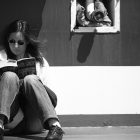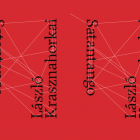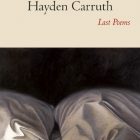Hearing Voices: Women Versing Life presents Katherine Case and Meridian Press
I knew Katherine Case as a poet first. We were in a poetry workshop together at Mills College, and I was enthralled with her ability to integrate so many ideas into a poem that was usually one breathless sentence. Little did I know that when class ended, and I was bobbing around in water aerobics, Katherine was discovering a whole new world of art in the letterpress studio.
After Mills, Katherine invited me to join her letterpress-printing poetry group, Thicket Press (including Jennifer Arin, Janell Moon, Yves Moralex, Annie Stenzel, Jennifer K. Sweeney, and Virginia Westover Weiner) and that’s when I discovered Katherine’s numerous talents. At the time she worked at San Francisco Center for the Book, where she taught us how to set type, get inky, crank the press, fold, and sew books so that with the addition of her gorgeous linoleum carvings, our words became works of art.
Katherine recently moved to Reno, Nevada, to start her own book arts business, Meridian Press, and she letterpress printed her own fine chapbook titled, Doppelganger: A Bestiary. She took time from her busy schedule to talk about printing and poetry as well as the shift into becoming a self-employed, work-at-home, mother-artist.
PC: I’m always blown away by your linoleum carvings. Were you an artist before letterpress printing? Was there a transition into printing and poetry?
KC: My undergraduate degree was a double major in fine art (painting and ceramics) and creative writing. Even though UW Madison has a great printmaking program, I didn’t take a class until grad school. As an undergraduate, I always felt like I would have to choose between writing and art, so when I found Mills College and learned about book arts and letterpress printing I was thrilled. I love that as an artist I can make more utilitarian things like books, cards, calendars; and I love that as a poet I can control the process of putting words on a page.
And really there is no better way to get to know another person’s poem than to set it in type and print it by hand. The other great thing that drew me to printmaking and letterpress printing is the medium’s combination of the industrial and the artistic— the hum and click of a Vandercook press, the greasy, inky smell of metal type and that lovely, decisive feeling one gets gouging a linoleum block.
PC: How do the printing and the writing influence each other? Could you compare and contrast the creative process for us?
KC: I think of my poetry as something that exists in my head. Writing is a method for me to process and understand the world, so the more I write the more calm and balanced I feel. Printmaking, on the other hand, is a craft, and it exists in my body. The process of observing nature and then creating a linoleum cut or a typographical composition is a physical process, and the more I do it the more I feel present in this moment and this place.
PC: Who are your influences in poetry and printing?
KC: I love the poetry of Mary Oliver, Robert Hass and Dean Young. I love the printmaking of Barry Moser, Tom Killion and Artemio Rodriguez. Mostly though, I am influenced by my friends who make poetry and art in Nevada and the Bay Area. Poets like Annie Stenzel, Jennifer K. Sweeney, the Ash Canyon group and of course you, Tricia. Printers like Maia K. de Raat, Rik Olson and Mary Laird.
PC: I’m so honored to be included in that list! I love the way animal life and human life reflect each other in your poetry and definitely throughout Doppelganger. Could you talk a little about the idea behind the title poem.
KC: Well, I guess it’s like you say, sometimes it seems like animal lives mirror our own, or I even sometimes think of it as parallel universes like in science fiction. When I wrote that poem I had been living for five or six years in a very, very small not especially sunny apartment in Berkeley. We had these old, old goldfish that lived in a not especially clean tank in the corner of the hallway. Proportional to our body sizes, our living spaces seemed about the same. I wondered about the fishes’ belief system and how it was shaped by what they saw outside the tank, and then about how my own was shaped by what I saw in my world. In the end, the world and what we believe about it are really just reflections of what we have experienced, right? So there was nothing less true about these goldfishes’ view of the world than my own. Two parallel universes: the truth of the goldfishes’ world and the truth of mine.
I chose the title Doppelganger because the idea that each of us has a twin living at the same time as us somewhere and that we may or may not ever encounter them is another way of talking about this idea of parallel, equal existences.
PC: Doppelganger is beautiful in so many ways. How did you choose/create your cover art?
KC: The typographic design for Doppelganger came to me in the middle of the night while I was up with my daughter. These days, when I am so busy with my family and other demands, I find myself sort of posting a question to my creative unconscious and then allowing it to ruminate there while I do other things. Then, when I have time to go back into the studio, I might have an idea to play around with. In the studio, all of my design and illustrations are done first through sketching and drawing. I seldom use a computer in my printmaking work.
PC: You’ve recently made some big changes: Leaving SFCB to start your own business/ becoming a work-at-home mom, and moving to Reno. Talk about making that leap.
KC: Although we miss our friends back in the Bay Area very much, my husband and I were both excited to make the move to Reno, where we really enjoy being so close to the Sierra Nevadas and where we’ve both started our own businesses. I knew it would be a challenge to change from being an arts administrator to being an artist but didn’t realize how challenging and rewarding it would be to work from home and now be a stay at home mom much of the time.
In our world it is so often our jobs that we use to define ourselves, so when I moved to Nevada and no longer had this easy thing to call myself (“studio manager” or whatever), I was forced to take a harder look at my life and all of its components (mother, poet, printmaker, wife) and think “What do I want to do with every day?” “What can I do with every day?” I struggle every day to find a comfortable place for my poetry within my printing business and my printing business within our family life. I find that the good days are really, really great, and I am able to not only be with my two little kids but also do something productive and contribute in some small way to the culture.
Doppelganger
We rearranged the furniture, cleaned the fish tank
and moved it to the hall table near the bathroom,
where now of our three old goldfish—
tennis-ball sized ancients whose cheek sacs
sag around their raggedy fins—
one has taken to watching me
as I get ready in the morning, or at night
walking past in slippers and an old t-shirt.
So that when the tank is the only light
and train noises come soft
through the open window, I think
of his steady dog-eyes,
catch myself looking again
out the open bedroom door.
What is this I cannot admit?
Am I nothing more than
an ill-defined shadow
of all the things he could not possibly know—
passing with a coffee cup most mornings
just when the sun almost reaches the far corner
of his green haze—
the mundane clockwork of his liminal world,
a parallel universe in which nothing happens,
in which I leave the apartment,
stand on the stairs and feel the thin warmth
of sunshine, illusion of light within darkness,
a ray just reaching the bottom of the well.
—
Katherine Case is a poet, letterpress printer and former Peace Corps Volunteer whose poetry has appeared in numerous national publications. She owns and operates Meridian Press in Reno, Nevada, where she publishes poetry chapbooks, broadsides and limited-edition prints of her hand-carved, multiple-color linoleum carvings.
(Images by Katherine Case.)



